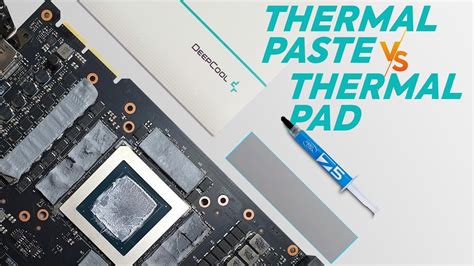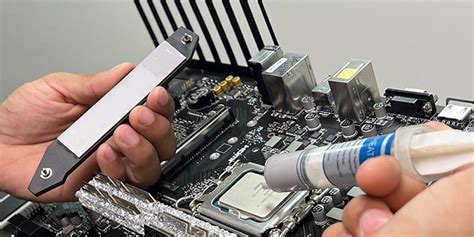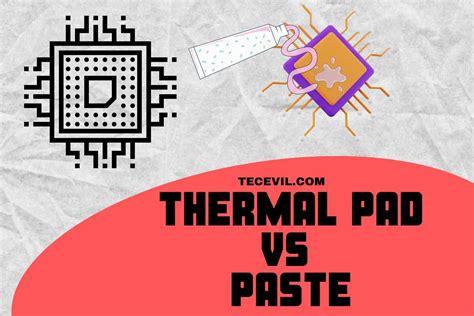What are Thermal Pads?
Thermal pads, also known as thermal interface pads, are pre-cut, semi-solid sheets of thermally conductive material. They are typically made of silicone or other polymers infused with thermally conductive fillers such as ceramics, graphite, or metal particles. Thermal pads are designed to fill the gaps between a heatsink and the heat-generating component, such as a CPU or GPU, to facilitate efficient heat transfer.
Advantages of Thermal Pads
-
Ease of use: Thermal pads are incredibly easy to apply. Simply cut the pad to the desired size (if necessary), remove the protective film, and place it between the heatsink and the component. No spreading or curing is required.
-
No mess: Unlike thermal paste, thermal pads are dry and do not create any mess during application. This makes them a cleaner option, especially for those who are less experienced with PC building or maintenance.
-
Electrical insulation: Most thermal pads are electrically insulating, which means they can prevent short circuits if they come into contact with other components or traces on the PCB.
-
Gap-filling ability: Thermal pads are thicker than thermal paste and can effectively fill larger gaps between the heatsink and the component. This is particularly useful when dealing with uneven surfaces or when the mounting pressure is not optimal.
Disadvantages of Thermal Pads
-
Lower thermal conductivity: In general, thermal pads have lower thermal conductivity compared to high-quality thermal pastes. This means that they may not be as efficient at transferring heat, especially in high-performance applications.
-
Limited conformity: Thermal pads are less conforming than thermal paste, which means they may not make as much contact with the surfaces of the heatsink and the component. This can result in air gaps, which can hinder heat transfer.
-
Higher thermal resistance: Due to their thickness and limited conformity, thermal pads typically have higher thermal resistance than thermal paste. This can lead to higher operating temperatures, particularly in systems with high heat output.
What is Thermal Paste?
Thermal paste, also known as thermal grease or thermal compound, is a viscous substance that is applied between a heatsink and a heat-generating component to enhance heat transfer. Thermal pastes are composed of thermally conductive materials, such as silver, ceramic, or carbon, suspended in a liquid or gel-like carrier.
Advantages of Thermal Paste
-
High thermal conductivity: High-quality thermal pastes often have higher thermal conductivity than thermal pads, which means they can transfer heat more efficiently. This can lead to lower operating temperatures and better overall thermal performance.
-
Excellent conformity: Thermal paste can conform to the microscopic irregularities on the surfaces of the heatsink and the component, creating a thin, even layer that minimizes air gaps and enhances heat transfer.
-
Lower thermal resistance: Due to its thin layer and excellent conformity, thermal paste typically has lower thermal resistance than thermal pads. This allows for more efficient heat dissipation, especially in high-performance systems.
-
Versatility: Thermal paste can be used in a wide range of applications, from small electronic devices to large industrial machines. It can be applied to various surfaces and is suitable for different heatsink designs.
Disadvantages of Thermal Paste
-
Application complexity: Applying thermal paste requires more skill and attention to detail compared to using thermal pads. Proper application techniques, such as using the right amount and ensuring even spreading, are crucial for optimal performance.
-
Messy: Thermal paste can be messy to work with, especially for those who are new to PC building or maintenance. Overuse or improper application can lead to spillage, which may cause damage to other components if not cleaned properly.
-
Curing time: Some thermal pastes require a curing time, which means they need to go through several heating and cooling cycles to achieve optimal performance. This can be time-consuming and may not be suitable for applications that require immediate use.
-
Electrical conductivity: Some thermal pastes, particularly those with metal-based fillers, are electrically conductive. This can pose a risk of short circuits if the paste comes into contact with other components or traces on the PCB.

Factors to Consider When Choosing Between Thermal Pads and Thermal Paste
-
Thermal performance requirements: Consider the heat output of your system and the desired thermal performance. High-performance systems may benefit more from thermal paste, while thermal pads may be sufficient for lower-power applications.
-
Heatsink design: The type and design of the heatsink can influence your choice. Some heatsinks may have a flat, smooth base that is better suited for thermal paste, while others may have a slightly uneven or textured surface that can benefit from the gap-filling properties of thermal pads.
-
Mounting pressure: The mounting pressure between the heatsink and the component can affect the choice between thermal pads and paste. Thermal pads can be more forgiving in situations where the mounting pressure is not optimal, while thermal paste relies on proper pressure to ensure good contact and heat transfer.
-
Ease of use and maintenance: Consider your level of experience and comfort with PC building and maintenance. Thermal pads are generally easier to apply and maintain, while thermal paste requires more skill and attention to detail.
-
Longevity and reliability: Both thermal pads and thermal paste can degrade over time, affecting their thermal performance. Consider the expected lifespan of your system and the recommended replacement intervals for each option.

Comparison Table: Thermal Pads vs Thermal Paste
| Factor | Thermal Pads | Thermal Paste |
|---|---|---|
| Ease of use | High | Moderate |
| Mess-free application | Yes | No |
| Thermal conductivity | Moderate | High |
| Conformity | Moderate | High |
| Thermal resistance | Higher | Lower |
| Gap-filling ability | High | Low |
| Electrical insulation | Yes | Some variants |
| Versatility | Moderate | High |
| Curing time | Not required | Some variants |
| Longevity | Moderate | High |

FAQ
-
Q: Can I use both thermal pads and thermal paste together?
A: While it is possible to use both thermal pads and thermal paste together, it is generally not recommended. Using both can lead to uneven heat distribution and may even worsen thermal performance. It is best to choose one option based on your specific needs and application. -
Q: How often should I replace thermal pads or thermal paste?
A: The replacement interval for thermal pads and thermal paste depends on various factors, such as the quality of the material, the operating conditions, and the specific application. As a general rule, thermal pads should be replaced every 2-3 years, while thermal paste should be replaced every 3-5 years or whenever you notice a significant increase in operating temperatures. -
Q: Can I reuse thermal pads or thermal paste?
A: It is not recommended to reuse thermal pads or thermal paste. Once removed from the heatsink or component, they may have lost their original shape or consistency, which can negatively affect their thermal performance. Always use fresh thermal pads or paste when remounting a heatsink. -
Q: What should I do if I accidentally spill thermal paste on other components?
A: If you accidentally spill thermal paste on other components, it is crucial to clean it up immediately to prevent short circuits or damage. Use a lint-free cloth or cotton swab dipped in isopropyl alcohol (90% or higher) to carefully remove the thermal paste from the affected areas. Be sure to let the components dry completely before reassembling your system. -
Q: Are there any alternative thermal interface materials besides pads and paste?
A: Yes, there are other thermal interface materials available, such as thermal tapes, phase-change materials, and liquid metal compounds. Each of these options has its own unique properties, advantages, and disadvantages. However, thermal pads and thermal paste remain the most common and widely used solutions for the majority of applications.
Conclusion
Choosing between thermal pads and thermal paste for mounting your heatsinks depends on various factors, including thermal performance requirements, heatsink design, ease of use, and personal preferences. While thermal paste generally offers better thermal conductivity and conformity, thermal pads excel in ease of use, gap-filling ability, and electrical insulation.
Consider your specific needs and application when making a decision, and always follow the manufacturer’s recommendations and best practices for optimal results. Remember to replace thermal pads or paste periodically to ensure consistent thermal performance over time.
Ultimately, both thermal pads and thermal paste can be effective solutions for thermal management, and the best choice will depend on your unique situation. By understanding the differences, advantages, and disadvantages of each option, you can make an informed decision that will help keep your system running cool and stable.

Leave a Reply